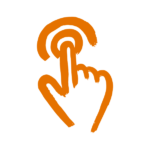Ways of communicating

There are thousands of ways to communicate and connect – be it through speech, sign language, touch, movement, gesture, sound, pictures, objects or electronic aids.
At Sense, we use whatever mix works best to help people who have complex disabilities, or are deafblind, to communicate and experience the world.
We call this our ‘total communication’ approach.
Remember, it’s never too late to start learning a new way of communicating. Have a go and don’t worry about getting it wrong.
Common ways of communicating include:
- Sign language.
- Makaton, a simpler version of sign language.
- Braille uses raised dots to touch.
- Deafblind Manual spelling words on to your hand.
- Lipreading.
How Sense can help
We offer free and impartial information about living with complex disabilities, including deafblindness.
Get in touch by phone, email, post or through a BSL interpreter.
Types of communication
These are the main ways of communicating that we use:
-

Using touch
- Braille uses raised dots to touch.
- Deafblind Manual spells words on to your hand.
- Block alphabet spells letters on to your hand.
- Moon uses raised lines, curves and dots to touch.
- Tadoma uses lipreading by touch.
- Hand-under-hand signing using touch.
-

Using signs
- Sign language.
- Makaton, a simpler version of sign language.
- Visual frame signing for people with reduced vision.
- Objects of reference
-

Using speech
-

Also
- Non-formal communication without speaking, writing or signing.
- Intensive interaction treats everything as communication.
This content was last reviewed in April 2023. We’ll review it again in 2025.
